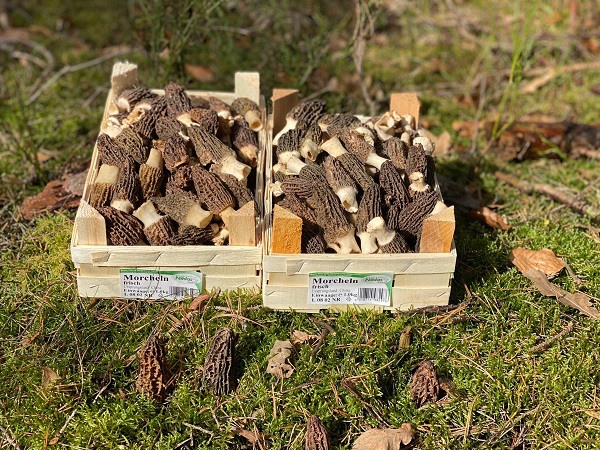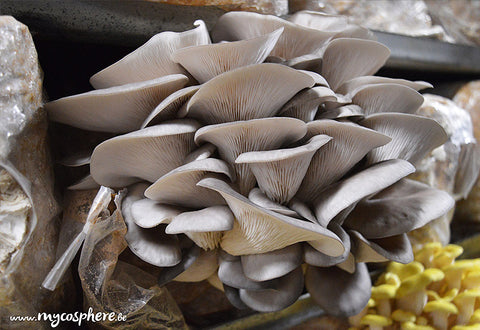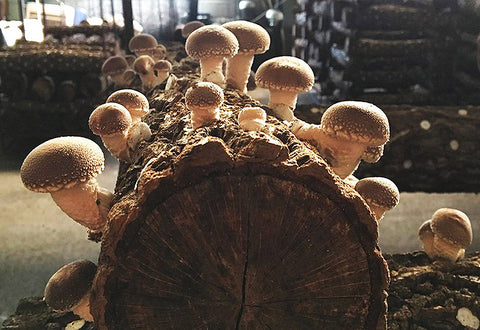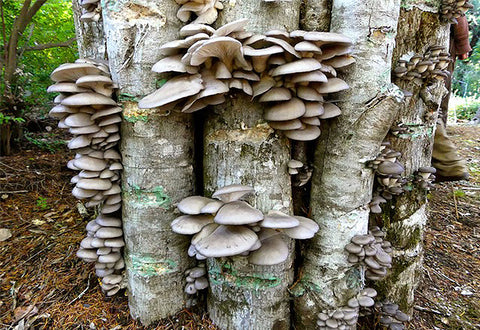Organic Morel Mushroom Grain Spawn
- As morels are generally grown outdoors, and are therefore a seasonal crop, the next mycelia will be available from mid-September 2024. You can now pre-order some by sending us an email
- Excellent edible mushroom
- Inoculation recommended between October and December
- Experiment with growing morels at home: in the garden, in a greenhouse, in the undergrowth
- To combine with our bags of sterilized grains
- Mycelium on BE-BIO-01 certified grains Agriculture Belgium
-
+- 2 weeks. Consult all our deadlines
Black morels, conical morel, morchella elata, morchella importuna.
An excellent edible mushroom, the black morel grows naturally in spring in forests, generally in rather calcareous soils. It is a very popular mushroom and particularly sought after for its refined taste.
Unlike other varieties of morels which are symbiotic and form mycorrhizae with specific plants, our variety is of the "saprophytic" type. This means that it will decompose dead matter and will not need a living host (tree) to be able to develop.
Mycelium storage: If you do not use the mycelium within 3-5 days of receipt, which is preferable, it is best to store it in fridge. It can thus be stored for 1-2 months before use.
Our commitment to quality:
We produce our mycelia in laboratory conditions, which guarantees the purity of the varieties and optimal quality.
We produce our mycelia 100% organically and all our products are certified “ BE-BIO-01, Agriculture Belgium ” by CERTISYS.
Note: Growing morels is more complex than many of the other varieties we sell on our site. Its culture remains relatively experimental, but research in recent years and the sharing of information has considerably advanced its culture. We guarantee the quality of the strain but we cannot guarantee the success of the cultivation. Do not hesitate to share your feedback with us with this culture.
Growing conditions
Morels are generally grown outdoors: in the vegetable garden under a shade sail, in a shaded greenhouse or in the undergrowth.
Sowing is generally done in late fall and early winter, between October and December. Temperatures must no longer exceed 20° (at the level just above the ground).
Late sowing can be done until the end of December in certain regions which do not have too many frosts. For colder regions, choose spring sowing after the last frost.

The biotope:
The objective is to reproduce the naturally optimal conditions of the morel. In the majority of cases, a shelter in the form of a tunnel with a shade sail will be necessary. Mycelium needs shade to grow well and will not tolerate direct sunlight. Think undergrowth or edge, and try to reproduce this brightness.
Avoid growing soils that have contained fungicides such as copper (contained in the Bordeaux mixture authorized in organic products for example), or even acidic soils or soils rich in tannins. Morels appreciate calcareous, basic soil. The pH is ideally at 7 or 8. This can be easily measured with pH measuring strips. Depending on needs, it may therefore be necessary to amend with calcium carbonate, Meudon white or limestone. Avoid lime rich in magnesium, which is generally not suitable for growing mushrooms.
As a secondary decomposer, morel mycelium will appreciate soil rich in already pre-decomposed organic matter. If you have wood chips, the ideal would be to let them compost for 1 year for example, and then integrate them into the first 5 centimeters of the soil in spring or summer. The manure must also be 2-3 years old before being mixed with the soil for the morels.
Morel mycelium resists light frosts well. If prolonged frosts below -5° are expected, try to further protect your mycelium by covering your tunnel with a thicker veil or tarpaulin.

Ground work :
The soil must have a small lump structure. Too fine hoeing with a tiller is not ideal. If your soil is moist or compact, a slight elevation of the growing beds will be beneficial. Light hilling allows drainage of excess water and better aeration of the soil.
Method / Technical Itinerary
1. Inoculation (seeding):
There are two options:
- The mycelium is broadcast (200 to 400 g of mycelium per square meter) and then covered or buried under 2-4 cm of soil.
- The mycelium is placed in "pockets" of 100 -200 gr and covered with 2-4 cm of soil (2-3 pockets per square meter). With this technique, the mycelium can be placed in terracotta pots, placed with the hole facing up and closed at the bottom. It is a slightly more laborious technique but it has the advantage of protecting the mycelium from contamination, limiting the impact of rodents, accelerating the "explosion" of the mycelium by giving it a direction with the opening towards the high, allow good respiration of the mycelium.
Some recommend at the same time as inoculation a light semi-cereal (wheat, rye, etc.) to cover the soil. This light vegetation will provide natural shade to the mycelium, some sugars from the roots, as well as protection from the winds and a more constant hygrometry favorable to the development of the mycelium. A semi that is too dense is not recommended
The soil before inoculation must be well moist to allow the good development of the mycelium. This can either be the result of rain or watering.
2. The explosion of the mycelium
The morel mycelium will leave the grains to explore its environment. It will appear on the surface of the ground in eccentric circles, called explosions. Depending on the biotopes and temperatures this can take 1 to 3 weeks and take on more or less marked aspects.

3. Feeding
The morel will feed first on its so-called “endogenous” food, that which is found in the soil. Quickly, the morel mycelium will then have to be fed with so-called “exogenous” food, which is placed on the ground. This gourmet mushroom needs a supply of sugars (starches, cellulose and simple sugars). Typically this supply is in the form of a bag of sterilized grains which will be placed with an opening towards the ground. Another technique is to bring cooked apples, cut in half and placed with the opening on the explosion of the mycelium.
The morel mycelium will thus pass from a rich environment (its point of inoculation), through an environment poor in nutrients (the earth) to once again go towards an environment rich in sugars (exogenous food). It is this alternation of richness of environment which will allow it to correctly develop its sclerotia, which will then allow it to produce beautiful morels.
These bags of food will be left in place for a few weeks, without touching them except in cases of contamination by mold or insects for example. By carefully observing the bags, you should see the mycelium colonize the grains in the days following installation. Around March-April, when temperatures start to rise, around 2-3 weeks before fruiting, these bags will be removed.
4. Incubation
Total incubation takes between 1.5 and 4 months. After feeding, the mycelium will gradually take on orange and then brown colors. At this stage, the mycelium draws its necessary resources from exogenous food and brings it to the earth, a poor environment. It will concentrate and store its resources there in the form of sclerotia, which will subsequently produce beautiful morels.
5. Watering.
Since mushrooms are made up of almost 90% water, humidity is a crucial factor. The soil should be well watered before inoculation. A few weeks before fruiting, the soil must also be well watered several times. Avoid strong jets of water which will damage the mycelia on the surface. Favor gentle watering using perforated pipes or micro-droplets in the morning. In the event of heavy rain, protect your mycelium well with, if necessary, a double shade sail.
6. Fruiting
Mushrooms will begin to grow when soil temperatures rise. At this stage, the mycelium will need more light. This can be done naturally because the days start to get longer, and this can be accompanied by removing part of the shade sail during the day, for example. At night, we always cover them with a veil to limit the risk of frost.

The appearance of “primordias” (fungus starts) is a delicate period. The primordia are very sensitive and fragile, and you must therefore be vigilant during this period by avoiding direct rays of the sun, the drying of the wind, the beating of the rain, the frost,... and at the same time, they will need a little light to develop properly, and constant humidity.
7. Harvestsare generally done between February and May, when temperatures rise to around 20° and the soil warms up. Maintain moist soil throughout mushroom growth. Morels are harvested when they measure around 10 cm.

Productivity
Productivity depends on a multitude of factors:
- The quality of the substrate (soil, organic matter, soil bacteria, etc.),
- Weather,
- Crop maintenance or the gardener's "fungal hand".
With a well-performed crop, you can expect 200 to 300 gr per square meter.

Precautions
The morels must be cooked. They are toxic when raw.
If this is your first time eating this species, it is best to start with a small amount to check for allergies, even if they are cooked.
Allow +- 10 minutes of cooking in a pan or saucepan for good cooking.
Frequently asked Questions
Is it normal for my mycelium to have a brown color?
The morel mycelium will go through different stages of maturity, which will give it white, orange, and then brown colors.
Should I water my crop?
Being more of a winter crop, the land is generally naturally humid. Two periods to take into account: before innoculation, the soil must be very humid for the mycelium to get off to a good start, and in spring when the soil warms up it is often necessary to add water to keep the soil moist.
Does it grow back every year after?
No. Since they are a saprophytic variety, they decompose dead matter and do not mycorrhize with surrounding trees. After fruiting, the morel mycelium is weakened. It is also quite sensitive to heat and drought, so it generally does not survive the summer unfortunately, unless the environment remains cool and humid all summer.
Is it possible to grow them indoors?
It is possible, and it has already been achieved in Denmark. However, growing morels outdoors is already relatively complex and experimental, growing indoors will be even more so. The complexity is not so much in the colonization of a substrate by the mycelium as in the technical conditions necessary for its fruiting.
Do cultivated morels taste the same as wild morels?
Yes, morels grown outdoors can taste just as good as those harvested in the woods. What will give the taste is the quality of the soil and its richness in organic matter. Too much watering or rain during fruiting will also reduce the taste of morels. For better conservation and better taste, do not harvest morels immediately after rain.
Is it compatible with other crops in the vegetable garden?
Yes. Morel mycelium takes root mainly from October to December, and is harvested from February to May. Morel mycelium will feed, among other things, on the dead roots of cultivated plants.
I have acidic soil, will this work?
No, morels need basic soil. You will then need to add lime, or calcium carbonate to raise the pH above 7, before implanting the mycelium.






